Research & Teaching
A Hands-on Activity to Understand the Nature of Science and Authentic Scientific Inquiry in Large Laboratory Courses
What’s in the Box?
Journal of College Science Teaching—May/June 2023 (Volume 52, Issue 5)
By Lin Xiang and Madhusudan Srinivasan
Integrating authentic research practices into introductory laboratory courses to prepare tomorrow’s scientists has become increasingly prevalent over the past decade. However, an incomplete understanding of the nature of science (NOS) and authentic scientific inquiry (SI) precludes higher-level learning in undergraduate research experiences. In this article, we discuss a concise, low-cost, low-maintenance, hands-on activity—What’s in the Box (WiB)—which is suitable for large-enrollment science courses at both the secondary and postsecondary levels and can help develop students’ understanding of NOS and authentic SI. Analyses of the postlab reflective writing assignment showed a substantial increase in the students’ appreciation for NOS and SI tenets; the top two NOS tenets were that scientific ideas are subject to change and that science demands evidence, identified in 20% and 18% of the reflective writings, respectively. The most appreciated authentic SI tenets were that SI is complex and iterative (reported in up to 32% of the reflective writings) and SI involves observation and exploration (reported in up to 12% of the reflective writings).
Teaching about the nature of science (NOS) and authentic scientific inquiry (SI) is an essential goal of science education. The general view of NOS in current science education documents depicts science as a human endeavor that demands empirical observations and is subject to change in light of new evidence (American Association for the Advancement of Science, 1993; National Research Council, 2012). Authentic SI typically refers to the process of science that consists of various methods and practices through which scientists generate scientific knowledge in daily research work (Dunbar, 1995; Latour & Woolgar, 2013; Schwartz et al., 2004). Contemporary science education documents such as Project 2061: Benchmarks for Science Literacy (American Association for the Advancement of Science, 1993), the Next Generation Science Standards (NGSS Lead States, 2013), and the National Science Teaching Association’s (2020) position statement on NOS have proposed a collection of the tenets that students should understand about NOS and authentic SI in learning science.
Students’ views of NOS and authentic SI may influence their performances in science courses and affect their real-life decisions on science-based issues (Driver et al., 1996; McComas et al., 1998). Despite the extensive efforts invested in promoting students’ understanding of NOS and authentic SI, reviews have revealed that many K–12 students in the United States still fail to learn these topics adequately (Deng et al., 2011; Lederman, 2007). Additionally, undergraduate students in various disciplines exhibit an inaccurate understanding about the tentative, empirical, inferential, theory-laden, and imaginative and creative nature of scientific knowledge, and they often view scientific inquiry as a universal, linear process that consists of a set of fixed steps and provides truths (Abd-El-Khalick, 2006; Abd-El-Khalick et al., 2004; Cartrette & Melroe-Lehrman, 2012; KaraKaş, 2008; Miller et al., 2010; Nadelson & Viskupic, 2010).
Along with the revolutionary developments in science in the second half of the 20th century, tomorrow’s scientists must understand the NOS and develop the ability to apply the scientific inquiry process. Unfortunately, explicit instruction on NOS at the postsecondary level and its effects have not been adequately studied over the past 2 decades. In the field of biology education, Drayton et al. (2013) reviewed 110 studies on biology lab instruction published between 1987 and 2007, and they found that only 10% addressed the NOS. Another review on 111 lab-based instructional studies published in The American Biology Teacher between 2007 and 2012 revealed that only 3% of the instruction focused on NOS (Puttick et al., 2015). Compared to NOS, authentic SI is better represented in undergraduate science curricula (Gormally et al., 2011; Weaver et al., 2008). However, a review of 60 undergraduate research experiences (Linn et al., 2015) found that only one third of these studies included students’ understanding of scientific practices as either a learning goal or a measured outcome. Clearly, the current status of students’ understanding and college instruction on NOS and SI justifies developing effective instructional interventions to enhance students’ understanding of both.
Mystery Box (also known as Black Box) is a type of inquiry-based, hands-on activity that has been widely used to explain the tenets of NOS. In these activities, students are tasked to deduce the contents or internal configuration of a sealed container through indirect observations. The Mystery Box activity can be either domain specific or domain general. For example, Abd-El-Khalick (2002) designed a Mystery Box through which ping-pong balls could be passed, resembling the task of decipering the internal structure of an atom. Miller (2014) and Briggs (2019) designed college-level, domain-general Mystery Tube activities to teach NOS. The post-activity surveys and interviews suggested the participants were better informed about the tentative, empirical, inferential, and creative nature of scientific knowledge (Abd-El-Khalick, 2001; Miller, 2014). Mystery Box activities were also used to teach the process of science. Chien and Godshall (2005) described a Magic Water activity to teach hypothesis generation and the iterative inquiry process. Students hypothesized the internal configuration of a sealed box by examining the patterns of water input and output. Cook and Cook (2015) used a Mystery Box activity in a college lecture setting to emphasize the steps of scientific inquiry. In addition, Mystery Box activities have been used to teach scientific inquiry skills in elementary schools with much success (Cavallo, 2007; Rule, 2007; Santos & Centurio, 2012).
In this article, we describe the What’s in the Box (WiB) activity, which targets NOS and SI tenets (Table 1) that were prominent and most misunderstood by students (Abd-El-Khalick, 2006; Abd-El-Khalick et al., 2004; Cartrette & Melroe-Lehrman, 2012; KaraKaş, 2008; Nadelson & Viskupic, 2010). This work builds on the existing Mystery Box activities and advances them in three ways. First, our WiB activity attempts to educate students about both NOS and authentic SI in secondary and postsecondary science courses, especially for large-enrollment science lab courses. Second, an explicit and reflective instructional framework (Clough, 2006; Lederman & Lederman, 2004) is used to develop the learning activity that requires students to identify, use, and reflect on the targeted tenets of NOS and authentic SI. Third, we use qualitative content analysis to identify the changes in students’ views on the target tenets of NOS and authentic SI after the activity.
Activity materials and preparation
The setup of the WiB activity consisted of two sealed cardboard boxes containing one or two small objects (Figure 1a). The shape of the objects ranged from those of simple geometry (e.g., spheres, cubes, cylinders) to those that were a combination of simpler shapes to produce more complex geometry. Some of the objects we used were wooden blocks, balls, batteries, test tubes, bolts, and nuts, all readily available at dollar or hardware stores. The inclusion of metallic magnetic objects allowed students to explore the contents with a strong magnet in addition to deciphering shape and sound cues, making the exploration process richer and more interesting. Students could handle the boxes to explore their contents but were not allowed to open the boxes. In addition to the sealed boxes, we provided a set of candidate objects (Figure 1b) and identical empty boxes that allowed students to construct similar boxes for testing the hypotheses at a later point in the activity. Other materials needed for the activity include electronic scales, heavy-duty magnets, whiteboards or sticky chart papers, colored markers, inquiry practice slip sets, and activity sheets (see Online Appendix A). At our university, the enrollment of the lab course ranged from 450 to 700 students each semester, and the enrollment per lab section was 25 students. A complete list of materials for such a section is provided in the course materials (see Online Appendix A).
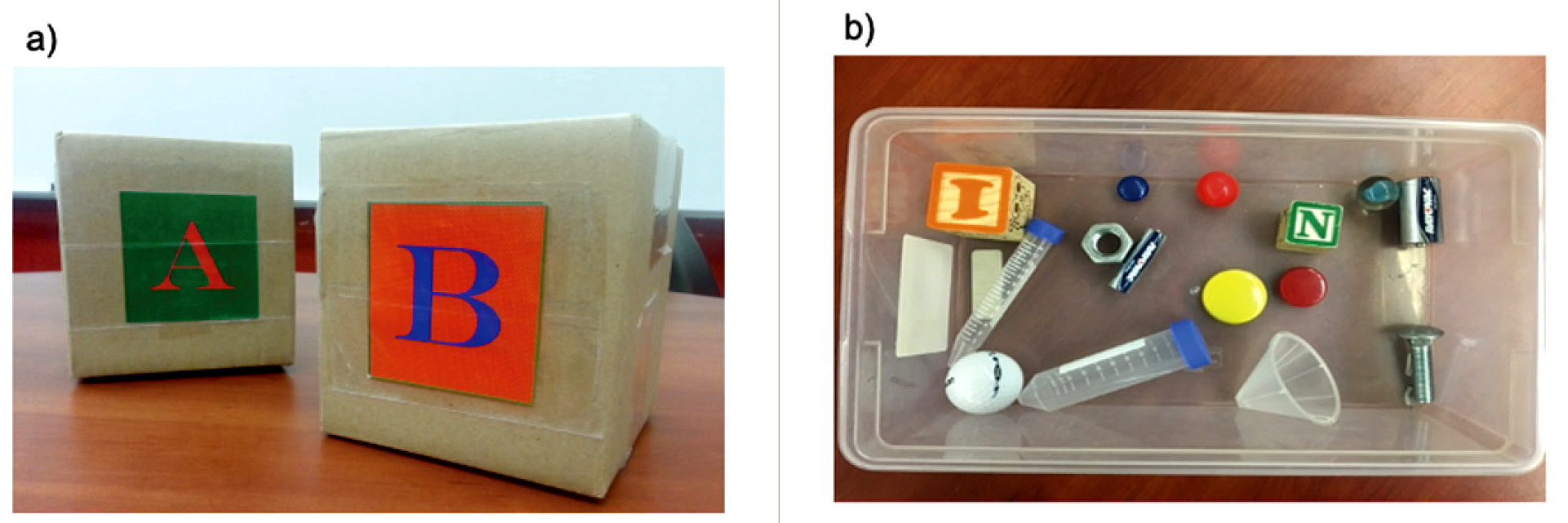
Sealed boxes and potential candidate items that were placed in the boxes.
Note. (a) Cardboard boxes (22.86cm x 22.86cm x 22.86cm/9” x 9” x 9”) obtained from an office supply store. These boxes were sealed before the start of the activity and kept sealed during the activity. (b) Examples of candidate objects, some of which were placed in the sealed boxes.
The box design meets several instructional needs and addresses inclusivity in the classroom. First, the investigation is domain general so that all students can participate, regardless of their academic background. Second, the two boxes have different complexity so that they engage students at different difficulty levels. Third, students may collect both qualitative and quantitative data on the objects. Fourth, both boxes are durable and damage-resistant because no breakable or liquid material is involved. Fifth, the boxes are low-cost and low-maintenance and therefore are particularly suitable for a large-enrollment lab course. Sixth, the investigation can be completed in one lab session of 100 minutes.
Lab activity: Instructional approach and student experiences
Our activity procedure is structured using the 5E Instructional Model (Engage, Explore, Explain, Elaborate, and Evaluate) developed by Bybee et al. (2006). Based on the explicit and reflective instructional framework, students were informed that the lab focused on illustrating some salient tenets of NOS and authentic SI related to doing science in the real world. To this end, small-group and whole-class discussions were held when students conducted WiB investigations. A reflective writing assignment was given after the lab to assess student learning outcomes. We strived to ensure that the investigative components of the activity mimicked the authentic SI process and exemplified the targeted tenets (Table 1).
Engage (15 minutes)
At the beginning of the class, students worked in groups to map out an authentic SI process based on their current knowledge using a set of 12 inquiry slips that represented the main practices in the SI process. These slips were derived from Reiff et al.’s (2002) “inquiry wheel.” Students were given about 15 minutes to discuss their thoughts within their groups and arrange the slips on chart paper. Meanwhile, the instructor discussed the map with each student group. To help students better express ideas in the map, the instructor asked guiding questions (e.g., Is your map intelligible to a person with little knowledge about authentic SI? How would you modify it to make it more understandable?). These questions often prompted students to add arrows or texts between the slips to make their charts more intelligible. This mapping activity both activated and assessed students’ prior knowledge of the authentic SI. When finished, the maps were displayed on the wall to share with the entire class. At this time, students predominantly presented authentic SI as a linear sequence of steps (Figure 2a).
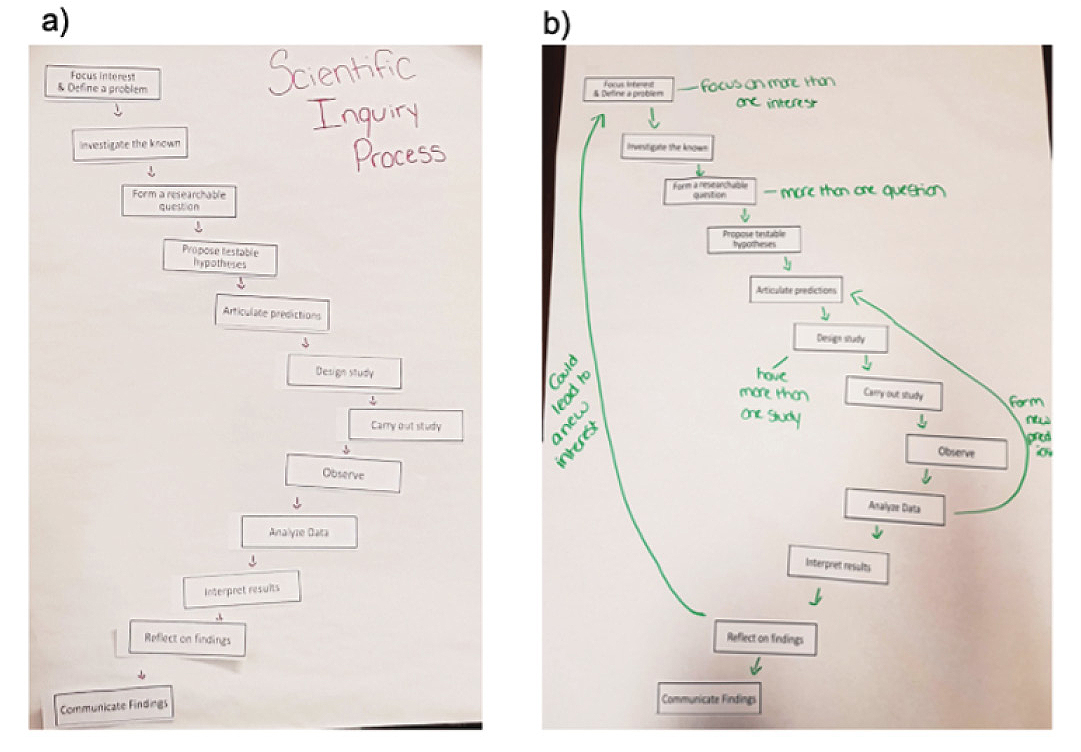
Students’ scientific inquiry maps.
Note. (a) Students typically depicted scientific inquiry (SI) as a linear process at the beginning of the WiB activity. (b) At the end of the activity, they typically indicated SI as a cyclical and more complex process.
Explore (15 minutes)
Next, each student group was presented with and invited to explore two sealed boxes that contained unknown objects (3–5 minutes). Students were discouraged from sharing their thoughts about the contents during the initial exploration to ensure independence in deductions. This short exploration further piqued students’ curiosity about the items in the boxes. The instructor then took advantage of students’ curiosity and encouraged them to gather evidence to infer the identities of the items in the boxes. Students were free to use any methods (except opening the boxes) to gather evidence and then propose hypotheses about the contents. They were asked to keep their observations to themselves until all of the group members finished exploring. They assessed the weight of the boxes, shook the boxes, listened to the resulting sounds, and even smelled the boxes.
While students discussed their explorations, the instructor walked around to listen to their ideas. Students often confused evidence with hypotheses at this stage, so this was a good opportunity for the instructor to discuss the distinction between observations and inferences within small groups. When students had gathered some observations using their basic senses, the instructor offered them an electronic scale and two magnets to expand their exploration; this helped students realize that data can be collected in different ways and hypotheses may be changed based on new observations. Most of the groups were able to complete the exploration and depict their group’s evidence and hypotheses on a fresh chart paper in about 15 minutes.
Explain (25 minutes)
Once all the groups completed the exploration, they shared their evidence and hypotheses with the whole class (Figures 3a and 3b). Students were often intrigued that different groups proposed very different hypotheses about identical boxes; this presented a great opportunity to emphasize how personal biases can lead to alternative hypotheses. The instructor also reinforced the distinction between observation and inferences in the whole-class discussion. The whole-class discussion helped cement several tenets of NOS and authentic SI, such as that science demands evidence, science is a blend of logic and imagination, and multiple research methods are used to collect data.
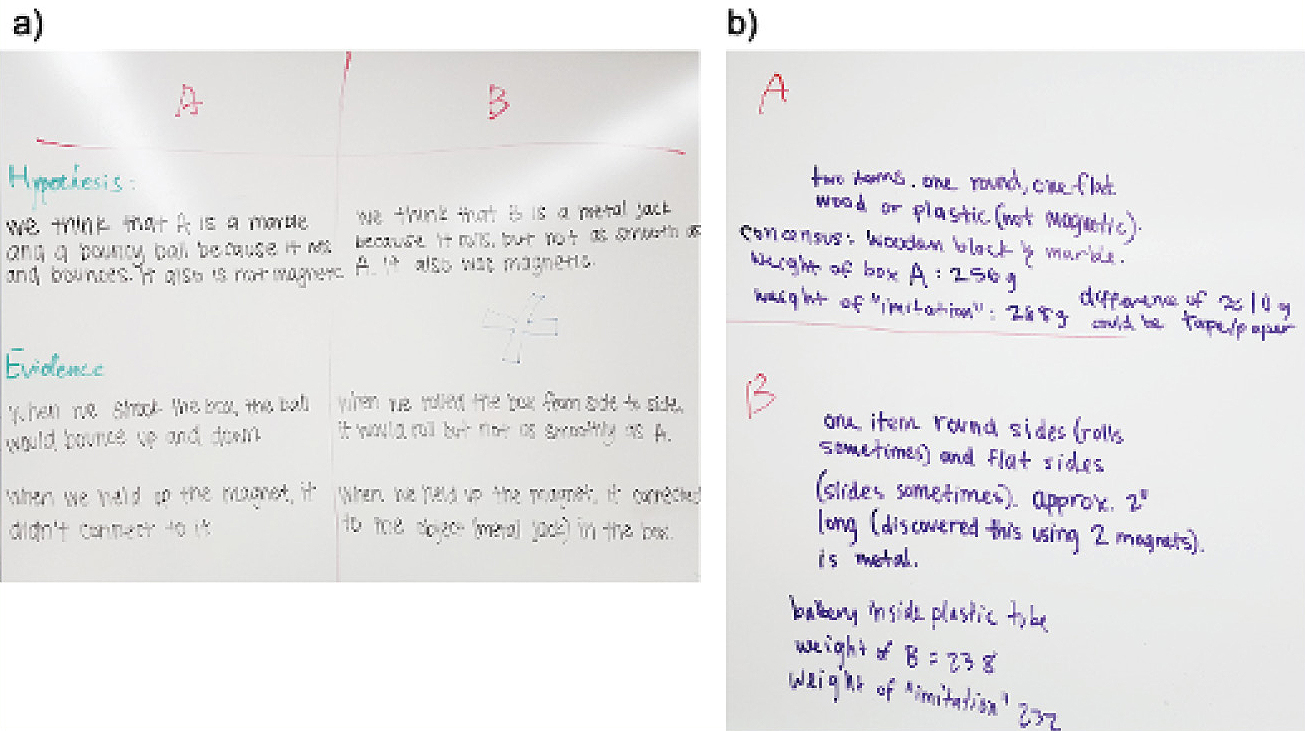
Examples of students’ hypotheses on the sealed boxes and the corresponding evidence.
Note. (a) Students were asked to present their hypotheses in text, drawings, or both. (b) Students were expected to gather both descriptive and numeric data as evidence.
Elaborate (45 minutes)
Following the class discussion, students were asked to systematically test their hypotheses as scientists would during an authentic scientific inquiry—without opening the boxes. Students generated various ideas; several suggested constructing new boxes based on hypotheses and comparing them to the sealed ones. To facilitate this process, we provided students with empty boxes and candidate objects, including those in the sealed boxes. Before letting students test their ideas, the instructor reminded students to record data systematically; they were also encouraged to add new evidence and revise their hypotheses on the chart paper. When they finished testing, students were invited to consider revising their SI process map. At this point, we noticed that most of the groups that had originally depicted the SI process as a sequence of linear steps modified their maps to present it as a cyclical process or a network of steps (Figure 2b).
A whole-class discussion was then held so students could share new evidence, hypotheses, and SI process maps. The instructor projected the target tenets of NOS and SI on a board and asked students to connect their thoughts and experiences to the target tenets. Students discussed which tenets of NOS were represented in the WiB activity. The groups also discussed how and why they revised their SI maps—in other words, they shared what experiences from the WiB activity influenced them to reconstruct their maps and question their prior understanding of NOS and authentic SI.
After discussing all of the targeted tenets of NOS and SI, students were informed that the boxes would not be opened to confirm their hypotheses. At first, many were disappointed and expressed their desire to know the contents. We treated this as an opportunity to further student understanding about NOS. Students were asked to consider the following questions:
- How often are scientists able to directly open their “boxes” when they study things that do not lend themselves to being “opened”?
- Do scientists always have someone to ask for the “correct” answers? If not, how do scientists know their results are valid?
To that end, the NOS tenets that science demands evidence, scientists try to avoid biases, and scientific knowledge is subject to change were reinforced. This final deliberation helped students further appreciate the need for evidence and the mutable nature of science.
Evaluate (homework)
After the lab, students were asked to conduct a reflective writing assignment about their learning experiences and views. They were told the writing would not be graded for accuracy but that they would be graded on making their best effort at deliberation. The following guiding questions were provided for the writing:
- Did the lab activity reinforce what you have known about scientific inquiry and NOS? How?
- Did the lab activity reveal any aspects of scientific inquiry and NOS that you have not noticed before? If so, what are those aspects?
- Do you disagree with any of the tenets of scientific inquiry and NOS discussed in class? If so, which ones? Explain why you disagree.
- Did the lab activity demonstrate all the tenets of scientific inquiry and NOS? If not, which ones were not reflected in the activity?
Teaching tips and differentiations
Here are some tips for implementing the activity and ways to vary it:
- In general, we can complete the entire activity in about 100 minutes. Most of our students were highly engaged in exploring the boxes and testing hypotheses, so it was important for the instructor to monitor student progress and help them manage time. If less time is available in one class period, the activity can be split into two class sessions, with the engage, explore, and explain phases in the first session and the elaborate phase in the second. In addition, students may be asked to test their hypothesis on one of the boxes in the elaborate stage to shorten the investigation time. However, we recommend not skipping the elaborate phase for two reasons: (i) The phases of explore, explain, and elaborate together make up a complete inquiry process; and (ii) testing hypotheses is central to scientific inquiry.
- This WiB activity embodies multiple tenets of NOS and authentic SI. We find it is beneficial to have students first discuss some of these aspects within small groups, followed by having a wrap-up discussion with the whole class. The small-group discussions may prepare students for the whole-class discussion and provide a more inclusive experience.
- Students differ in their modes of presenting ideas. We find it is helpful to let students write their hypotheses and illustrate them via drawings.
Assessments of student learning
Reflective writings may serve as an active-learning strategy and a formative assessment of students’ experiential learning outcomes (Mayne, 2012; McDonald & Dominguez, 2009). Therefore, we conducted a qualitative content analysis (Hsieh & Shannon, 2005) on students’ postlab reflective writings to assess whether and to what extent the WiB activity advanced students’ view on the targeted NOS and SI tenets. The population of this assessment was the students enrolled in the introductory biology laboratory at the University of Kentucky in the spring 2015, fall 2015, and spring 2016 semesters. More than 1,500 students completed the course in those semesters. This lab is a required course for biology majors. However, more than 60% of the students enrolled in the course were nonbiology majors. More than 80% of the students enrolled in the lab course were freshmen and sophomores (see Online Appendix B for demographic information).
A total of 1,371 students enrolled in the lab course submitted their reflective writings in the 3 semesters. We randomly and proportionally sampled 140 reflective writings from the 1,371 submissions from the 3 semesters to ensure an adequate representation. The sampled reflective writings were organized and coded using NVivo 12 software. To identify the conceptual changes in perception, we focused on both students’ responses to the guiding questions (“Did the lab activity reveal any aspects of scientific inquiry and NOS that you have not noticed before? If so, what are those aspects?”) and the statements that included the indicator phrases that suggest a change in students’ views (e.g., “I had never realized that …,” “I did not know …,” or “I was surprised …”). We first identified the text segments that referenced an idea relating to NOS or SI. Next, the text segments were coded into small thematic categories and then grouped based on the targeted tenets. The frequencies of these categories were used to determine the extent to which the WiB activity influenced students’ views. Each thematic category was only counted once in a reflective writing, even if it was mentioned multiple times in response to the reflective questions.
Changes in students’ view about NOS
A total of 87 excerpts were identified from the 140 sampled writings that indicated changes in students’ views of all six target tenets of NOS. The most cited tenet was that the scientific idea is subject to change, as seen in 20% of the student writings (Figure 4). These students mentioned that the WiB activity helped them appreciate this tenet because they found that they had to revise their hypothesis multiple times as new evidence emerged during the activity. The second most cited tenet was that science demands evidence. In 18% of the reflective writings, students reported that they realized a hypothesis is constructed based on what is known or observed, so they recognized the need for evidence to develop a testable hypothesis and support it with a rationale (Figure 4). The renewed appreciation for the idea that science is a blend of logic and imagination was represented in 12% of the student writings.
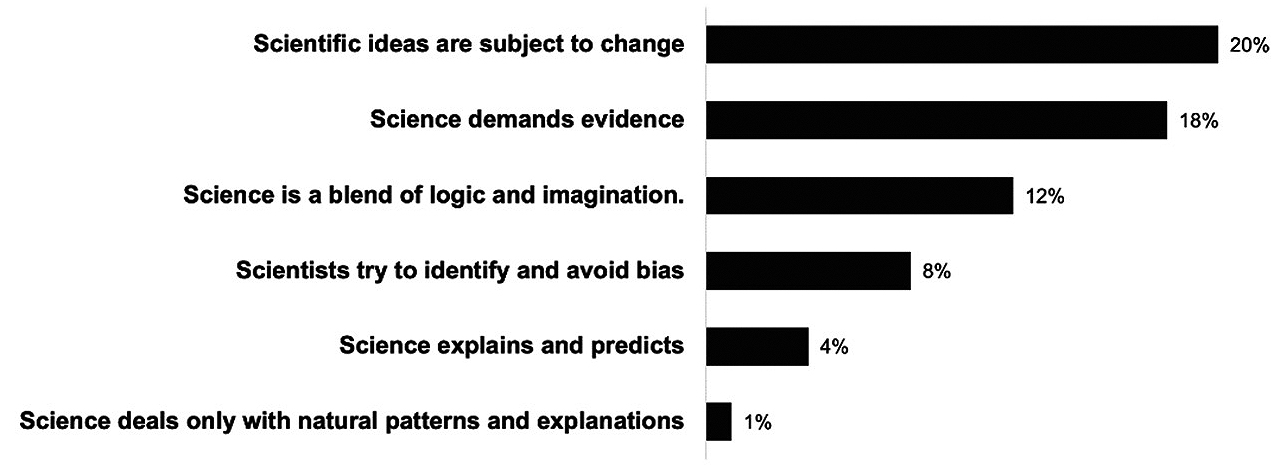
Percentages of students who reported renewed understanding or appreciation or learned about a given nature of science of tenet after the activity.
Note. n = 140.
Additionally, 41% of the students (57 out of 140 students) noted that the boxes were not opened at the end of the lab. Thirty-seven of these students acknowledged that they understood why the boxes were not opened. They realized that “some subjects may never be understood or solved in one’s lifetime” and researchers “get as close to the answer as possible.” Although 15 of the 57 students acknowledged the rationale for keeping the boxes sealed, they proposed multiple ways to observe inside the boxes directly. They suggested using X-rays or envisioned that technological innovations would eventually “open” the boxes. Five students appeared to misinterpret the purpose of keeping the boxes sealed and viewed it as an indication of failed experiments. One student noted, “This just goes to show that sometimes experiments fail or just do not work properly so you may not get the result that you want to from an experiment.”
Changes in students’ view about authentic SI
A total of 178 excerpts were identified from 140 sampled writings that revealed the changes in students’ views about authentic SI. These excerpts fell into 11 small thematic categories and were classified under four target tenets of authentic SI (Figure 5). Four categories were related to the tenet that SI is complex and iterative and can take many different paths. In 32% of the writings, students mentioned the WiB activities helped them realize that authentic SI is not a linear process, 28% of the sampled students recognized there is no single scientific method, 19% of the students highlighted that they needed to test their ideas in the activity iteratively, and 3% of the students indicated that they understood that SI is a complex process. Five categories were related to the tenet that SI involves observation, exploration, testing, communication, and application. Twelve percent of the students mentioned that they had not known SI involves intensive observation, 9% of the students expressed that exploring the boxes educated them about multiple SI practices of which they had not been aware, 6% of the students explained that they now realized that the different SI practices were interconnected, 4% of the students realized they needed to make inferences during the inquiry, and 2% of the students learned that SI generates new studies in the future (Figure 5).
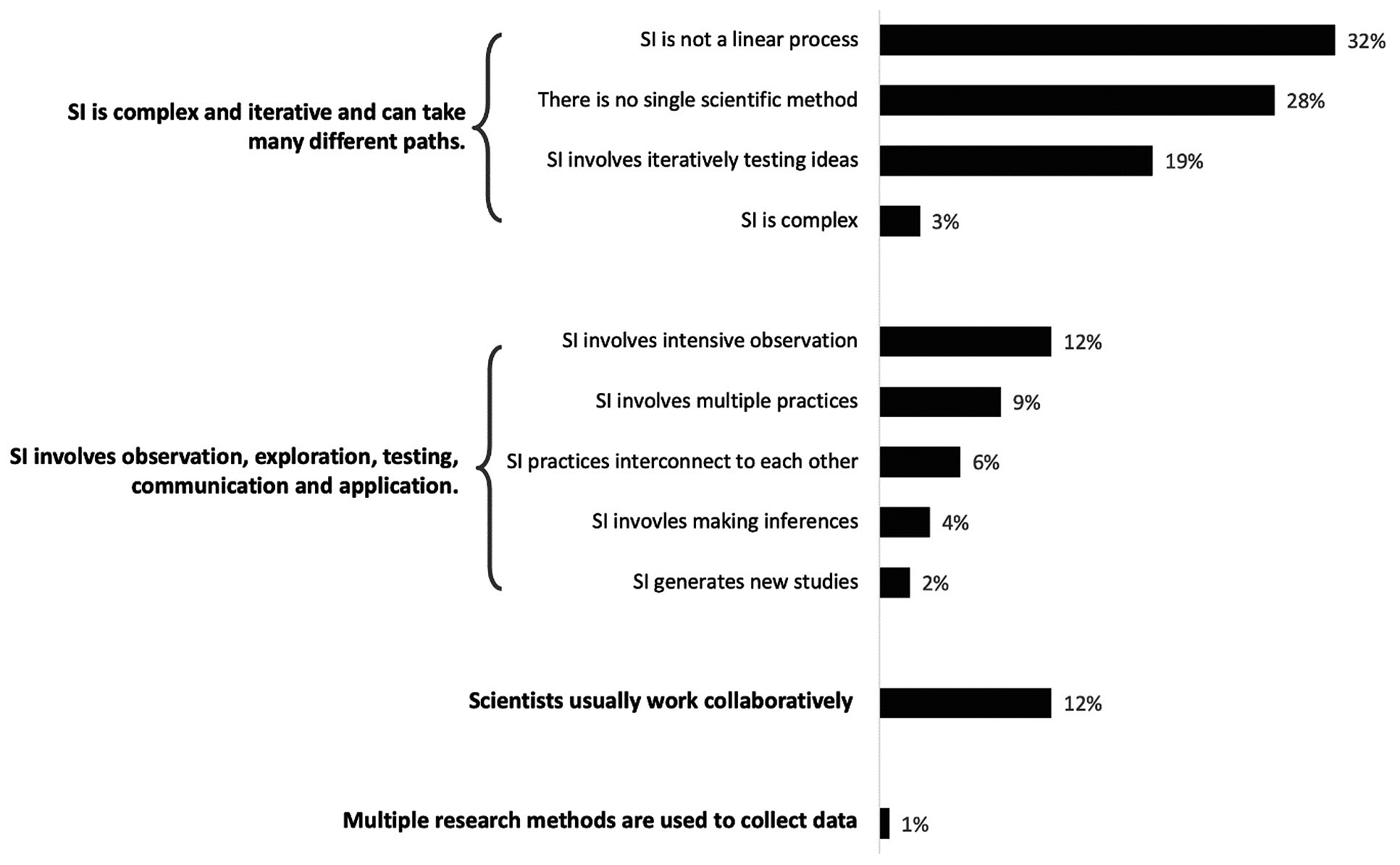
Percentages of students who became cognizant of or gained appreciation of a given tenet of scientific inquiry (SI) after the activity.
Note. n = 140.
Our assessment showed that an appreciable proportion of the sampled students demonstrated an improved understanding of multiple tenets of NOS and SI. It appears the WiB activity was most effective in reinforcing the following NOS tenets: Scientific knowledge is subject to change, science demands evidence, and science is a blend of logic and imagination. This result is consistent with Abd-El-Khalick (2001), who reported that most participants realized that theories and laws are subject to change and science requires imagination and creativity. Both Abd-El-Khalick (2002) and Miller (2014) stressed that the instructor must not open the Mystery Box at the end of the activity to illustrate the idea that scientific knowledge is mutable. The fact that 41% of the sampled students mentioned this in their reflective writings without being prompted demonstrates the effectiveness of this instructional design.
Although some students hoped the boxes could be opened, most other students accepted the idea that scientific knowledge can be uncertain, and they were able to relate it to the three most cited NOS tenets. The literature on the impacts of Mystery Box activity on students’ views of authentic SI is sparse. Our assessment shows that the idea that authentic SI is complex and iterative and can take many different paths struck a chord with our students. Additionally, we observed that nearly 100% of the students in our lab reconstructed their SI map into a cyclical or networking process at the end of the activity. These results suggest that the WiB activity may successfully address a prevalent student misconception in which students view SI as a general, linear, and fixed-step process. Because our population was an appreciable size (n = 1,371) and there was a significant proportional gain in student understanding, we believe our activity may have improved the outlook of a sizable number of our students about NOS and the scientific process.
Few students identified with the tenets that (i) science deals only with natural patterns and explanations and (ii) multiple research methods are used to collect data. In the case of the former tenet, we speculate that students might have a narrow view of natural patterns. Although they observed motion, sound, weights, and magnetism—all basic physical phenomena—while exploring the boxes, they might not consider these phenomena as natural patterns. Because this activity takes place in a biology lab and students are early in their college career, they might have an erroneous notion that only biological phenomena are responsible for natural patterns. Regarding the latter tenet, it may not have occurred to students that they are already familiar with at least three approaches for potentially determining the contents of the box: (i) using basic human senses, (ii) probing or measuring with magnets and weighing scales, and (iii) simulating candidate objects in a different set of boxes. We as instructors overlooked highlighting this fact during the wrap-up discussion.
Conclusion
At the time this article was written, more than 10,000 undergraduates at our university had experienced the WiB activity. Overall, we believe the WiB activity addresses the need in college science education for effective and efficient instructional interventions to enhance students’ understanding of NOS and SI tenets. We have detailed the pedagogical practices and provided course materials to enable the application of the same by science educators. Meanwhile, we encourage science educators to modify the activity to address the limitations discussed and meet their teaching goals and student needs.
Lin Xiang (lin.xiang@uky.edu) is an assistant professor of science education in the Department of STEM Education, and Madhusudan Srinivasan (madu@uky.edu) is a lecturer in the Department of Biology, both at the University of Kentucky in Lexington, Kentucky.
Inquiry Instructional Materials Research Teaching Strategies Postsecondary


